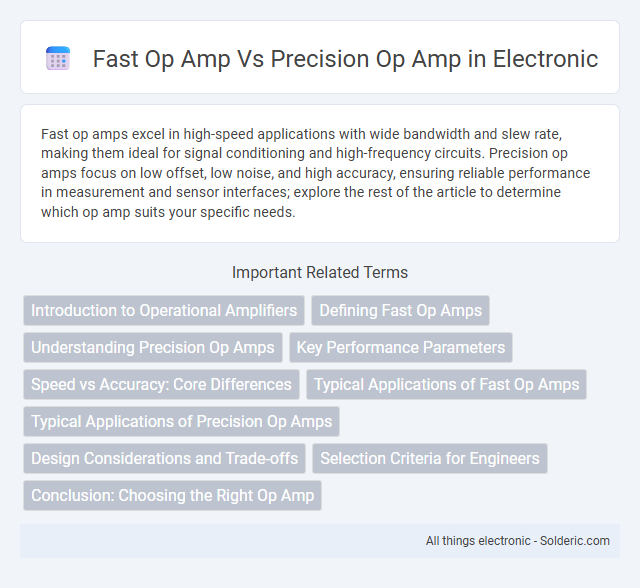Fast op amps excel in high-speed applications with wide bandwidth and slew rate, making them ideal for signal conditioning and high-frequency circuits. Precision op amps focus on low offset, low noise, and high accuracy, ensuring reliable performance in measurement and sensor interfaces; explore the rest of the article to determine which op amp suits your specific needs.
Comparison Table
| Feature | Fast Op Amp | Precision Op Amp |
|---|---|---|
| Speed | High slew rate, high bandwidth, ideal for high-frequency applications | Lower slew rate, optimized for stability over speed |
| Accuracy | Moderate accuracy, higher offset voltage and noise | Very high accuracy with low offset voltage and low noise |
| Applications | Video processing, RF circuits, high-speed data acquisition | Sensor signal conditioning, instrumentation, precision measurement |
| Power Consumption | Typically higher power consumption due to speed enhancements | Lower power consumption, optimized for stability and accuracy |
| Input Offset Voltage | Higher (several mV typical) | Very low (microvolts to hundreds of microvolts) |
| Noise | Higher noise figure | Low noise, suitable for precision applications |
Introduction to Operational Amplifiers
Operational amplifiers (op amps) serve as the fundamental building blocks in analog electronics, amplifying voltage signals in various applications. Fast op amps prioritize high slew rates and wide bandwidths to handle rapid signal changes efficiently, making them ideal for high-frequency or transient response circuits. Precision op amps focus on low offset voltage, low drift, and high accuracy, ensuring your measurements and signal processing maintain exactness and stability in sensitive instrumentation.
Defining Fast Op Amps
Fast op amps are designed for high-speed signal processing with high slew rates and wide bandwidths, making them ideal for applications requiring rapid response times such as video amplification and high-frequency communication circuits. Precision op amps, in contrast, prioritize low offset voltage, low drift, and high accuracy over speed, targeting applications like instrumentation and sensor signal conditioning. Your choice depends on whether speed or accuracy is critical for your specific electronic design parameters.
Understanding Precision Op Amps
Precision op amps deliver superior accuracy with low offset voltage, low bias current, and minimal drift over temperature, making them ideal for sensitive measurement and instrumentation applications. Fast op amps, on the other hand, prioritize high slew rates and bandwidth for high-speed signal processing but may compromise on precision characteristics. Understanding precision op amps helps you choose the right component for tasks requiring stable, accurate amplification and minimal error in DC and low-frequency signals.
Key Performance Parameters
Fast op amps excel in high slew rates and wide bandwidths, making them ideal for applications requiring rapid signal processing and high-frequency response. Precision op amps prioritize low offset voltage, minimal input bias current, and low noise for accurate and stable signal amplification in measurement and sensor systems. Understanding these key performance parameters helps you select the right amplifier to balance speed and accuracy based on your specific circuit requirements.
Speed vs Accuracy: Core Differences
Fast op amps prioritize high slew rates and bandwidth to handle rapid signal changes, making them ideal for high-frequency applications like RF and video processing. Precision op amps emphasize low offset voltage, drift, and noise to ensure accurate, stable measurements in sensor and instrumentation systems. The core difference lies in speed-driven transient response versus accuracy-focused signal fidelity.
Typical Applications of Fast Op Amps
Fast op amps are ideal for high-speed signal processing tasks such as video amplification, RF signal conditioning, and high-frequency ADC buffering where rapid transient response and wide bandwidth are critical. These op amps excel in applications requiring slew rates above 50 V/us and gain-bandwidth products often exceeding hundreds of MHz. Your system benefits from fast op amps when low latency and minimal signal distortion during high-frequency operation are essential.
Typical Applications of Precision Op Amps
Precision op amps are typically used in applications requiring high accuracy and low offset voltage, such as instrumentation amplifiers, sensor signal conditioning, and data acquisition systems. Their low noise and minimal drift make them ideal for medical devices, strain gauge measurements, and precision voltage references. Your designs benefit from improved signal integrity and measurement reliability when using precision op amps in these sensitive applications.
Design Considerations and Trade-offs
Fast operational amplifiers prioritize high slew rate and bandwidth to handle rapid signal changes, often sacrificing offset voltage and noise performance. Precision operational amplifiers emphasize low offset voltage, low drift, and low noise, which limits their bandwidth and speed due to design trade-offs in input stage architecture. Selecting between them depends on the specific application requirements, balancing speed against accuracy and stability in the amplifier design.
Selection Criteria for Engineers
Engineers select fast op amps when high slew rate and wide bandwidth are critical for applications like video processing or RF circuits, ensuring rapid signal response. Precision op amps are chosen for low offset voltage, minimal drift, and high input impedance, optimizing accuracy in sensor interfaces and measurement systems. Trade-offs include prioritizing speed over accuracy or stability based on the application's performance requirements and noise tolerance.
Conclusion: Choosing the Right Op Amp
Fast op amps excel in high-speed signal processing with slew rates exceeding 100 V/us, making them ideal for applications like RF communication and video amplification. Precision op amps offer ultra-low offset voltages under 10 uV and minimal drift, ensuring accurate sensor readings and stable DC performance. Selecting the right op amp depends on prioritizing speed for transient response or accuracy for low-noise, high-stability requirements.
Fast op amp vs Precision op amp Infographic

 solderic.com
solderic.com